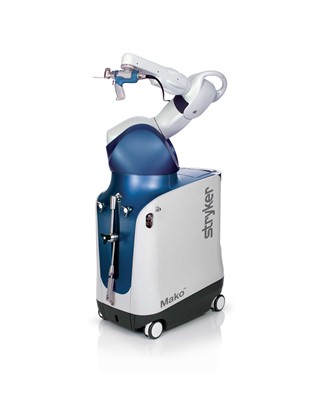What is Robotic Knee Replacement Surgery?
Robotic assisted total knee replacement surgery allows the joint replacement surgeon to selectively pinpoint the portion of the patient’s knee damaged by osteoarthritis, and then assists the surgeon with resurfacing the knee while sparing the surrounding tissue.
First, understand what knee replacement involves. The knee joint connects two long leg bones, held together by muscles, ligaments and tendons. Each bone end is covered with a layer of cartilage that absorbs shock and protects the knee. In knee replacement (also called knee arthroplasty or total knee replacement), the surgeon resurfaces parts of the joint damaged by arthritis. Metal and plastic parts (implants) are used to cap the ends of the bones that form the knee joint, along with the kneecap.
Robotic knee replacement surgery and conventional knee replacement both follow the same basic approach, but the robotic system gives the surgeon a more detailed view of the joint before and during surgery, enabling more control and consistency.
 “Robotic knee replacement surgery uses a computed tomography (CT) scan to allow for operative mapping of implant placement,” according to Dr. J. Conner Ryan, an orthopedic surgeon on the medical staff at Texas Health Center for Diagnostics and Surgery (THCDS). “The robot allows for accurate bony resections [removal of damaged bone] and functional placement of the implant to help improve balancing of the knee.”
“Robotic knee replacement surgery uses a computed tomography (CT) scan to allow for operative mapping of implant placement,” according to Dr. J. Conner Ryan, an orthopedic surgeon on the medical staff at Texas Health Center for Diagnostics and Surgery (THCDS). “The robot allows for accurate bony resections [removal of damaged bone] and functional placement of the implant to help improve balancing of the knee.”
The CT scan creates a 3D virtual model of each patient’s knee’s unique anatomy, creating an image of the shape and motion of the knee. This detailed view enables the surgeon to create a surgery plan that may be adjusted, if necessary, during the surgery. The model also helps the surgeon visualize the joint in motion for optimal placement of the implant. When the surgeon prepares the bone for the implant, the robotic arm guides the surgeon within the predefined area, allowing for a more accurate and better-aligned knee replacement.
Many patients ask: Is robotic surgery best for knee replacement?
“We do not yet have any current evidence that robotic surgery provides better results over the traditional instrumentation,” said Dr. Ryan. “But it has been shown to impart higher levels of accuracy and precision to the procedure.” That additional precision may help avoid damage to the soft tissue and ligaments near the knee joint, a potential risk of knee replacement.
Considering knee replacement? Request an appointment.
Let us help you determine if robotic knee replacement surgery is right for you.
What makes the robotic knee replacement surgery more advanced?
Dr. Ryan adds that robotic knee replacement surgery can be an especially useful tool for patients with limb deformities, or those who have pre-existing hardware that may impact placement of traditional instrumentation.
“In those cases, robotic surgery has been shown to improve alignment accuracy, because it allows for more control and consistency,” he said.
How the surgeon uses the robot for knee replacement surgery
Does the robotic system change the way the surgeon operates? Yes and no.
“The gist of the procedure is the same, but the robot offers some advantages,” said Dr. Ryan. “We can place additional pins in the femur and tibia that allow for arrays to be placed that help tell the robotic systems where the knee is in the space.”
What happens during surgery?
Before surgery, the patient undergoes a CT scan of the knee joint, which is used to generate a 3D virtual model of the patient’s anatomy. This virtual model is loaded into the Mako System software and used by the surgeon to create a pre-operative plan customized to that patient’s unique anatomy. 
In the operating room, the surgeon uses the robotic system to assist in performing the surgery based on that pre-operative plan. When the surgeon prepares the bone for the implant, the surgeon guides the robotic-arm within the pre-defined area. The robot helps the surgeon stay within the boundaries defined in the pre-operative plan while also allowing the surgeon to make adjustments to the plan during surgery as needed. In a laboratory study, Mako demonstrated accurate placement of implants to a personalized surgical plan. That improved accuracy may help protect damage to soft tissue surrounding the knee.2
Benefits of Robotic Knee Surgery
“Mako, along with other robotic assisted system (RAS) platforms, appear to improve the accuracy of implant alignment in total knee replacement,” Dr. Ryan said.
As with conventional joint replacement, surgeons typically do not recommend robotic knee replacement surgery unless conservative measures, such as NSAIDs and physical therapy, have been tried and failed to provide relief.
Recovery from knee replacement surgery is similar for both robotic and conventional joint surgery. Most patients who undergo joint replacement surgery at THCDS are admitted to the hospital overnight and return home the next day. Physical therapy usually begins soon after. The majority of patients will feel as though they made good progress with pain control and function between six weeks and three months after surgery. However, overall recovery time will depend on the patient’s functional and medical status prior to the surgery; some patients may take as long as a year to fully recover.3
As with any surgery, there are some procedure risks, which may include bleeding, infection, blood clots, or a loosening or wearing out of the prosthesis. While these complications are typically manageable, and infrequent, it’s important for patient to understand the potential for risk and discuss any concerns with the doctor prior to the procedure.
To learn more about knee replacement surgery at THCDS, click here. Explore the THCDS video library to learn more about total knee replacement.
Frequently Asked Questions (FAQs)
Is robotic knee replacement better?
Studies haven’t yet confirmed that robotic surgery provides better results over conventional joint replacement, but robotic knee replacement surgery has been shown to lead to higher levels of accuracy to the procedure.
Does insurance cover robotic knee replacement?
As a knee arthroplasty procedure, robotic joint replacements are typically covered by most Medicare-approved and private health insurers. However, some insurers may not cover the pre-op CT scan required for robotic surgery, which some imaging centers can provide for a reasonable fee. Patients will have the opportunity to review covered and uncovered costs, if any, prior to their surgery.4
The Bottom Line
If you or a loved one has been experiencing severe knee pain and are planning to undergo minimally invasive knee replacement surgery in Plano give us a call. Our friendly patient navigator is here to answer your questions.
Sources:
1 Mako Total Knee, Stryker (manufacturer) patient website. https://patients.stryker.com/knee-replacement/options/mako-robotic-arm-assisted-total-knee
2 Hartford Healthcare, https://thocc.org/services/orthopedics/departments-services/mako-technology
3 Source: Email interview with Dr. Ryan
4 Source: Email interview with Dr. Ryan
